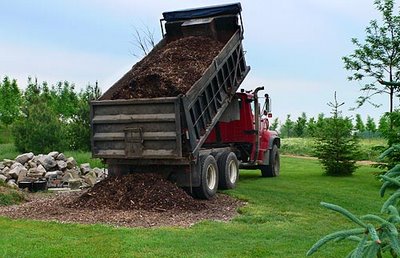
This week we got another dump truck load of wood chip mulch. We seem to go through one dump truck load each year. We top our planting beds with a three-inch layer of mulch, generally straw or wood chips. We do it to control weeds and keep moisture in the soil.
We also like to mulch our trees with leaf mould and wood chips to keep the grass mowable around them. (Otherwise, it's easy to get too close to a tree and injure the bark.)
We buy the composted wood chips cheaply from a tree service, and we get straw for the vegetable garden from a local farmer.
We find that mulch is a godsend for country gardening for these reasons:
• It keeps weeds down, mainly by blocking out the light they need to germinate – and if a weed manages to poke through, it's easier to pull it out when rooted in a layer of mulch than in the soil.
• Preserves soil moisture by reducing evaporation, and helps prevent erosion caused by rain and wind. Bare soil often gets a crust on it that prevents rain from penetrating easily.
• Keeps soil temperatures cool in summer and helps to reduce the risk of damage to plant roots in winter.
• Helps keep soil from splashing onto leaves, which keeps plants looking neater and helps prevent soil-borne fungal diseases.
• As mulch decomposes, it adds all-important organic matter to the soil and keeps the top layer of soil loose and airy.
You may have heard that mulches high in carbon — anything brown — can steal nitrogen from plants. Instead of being there for the plants, soil nitrogen gets used up by the soil micro-organisms in the process of breaking the stuff down.
But this isn't a problem if you layer wood chip or bark mulch mulches on top of your soil. Just avoid mixing them into the soil.
Some people add fertilizer to make up for any nitrogen used to break down mulches. I rarely bother with added fertilizer. I garden in rich clay loam, which seems to grow plants just fine without it.



